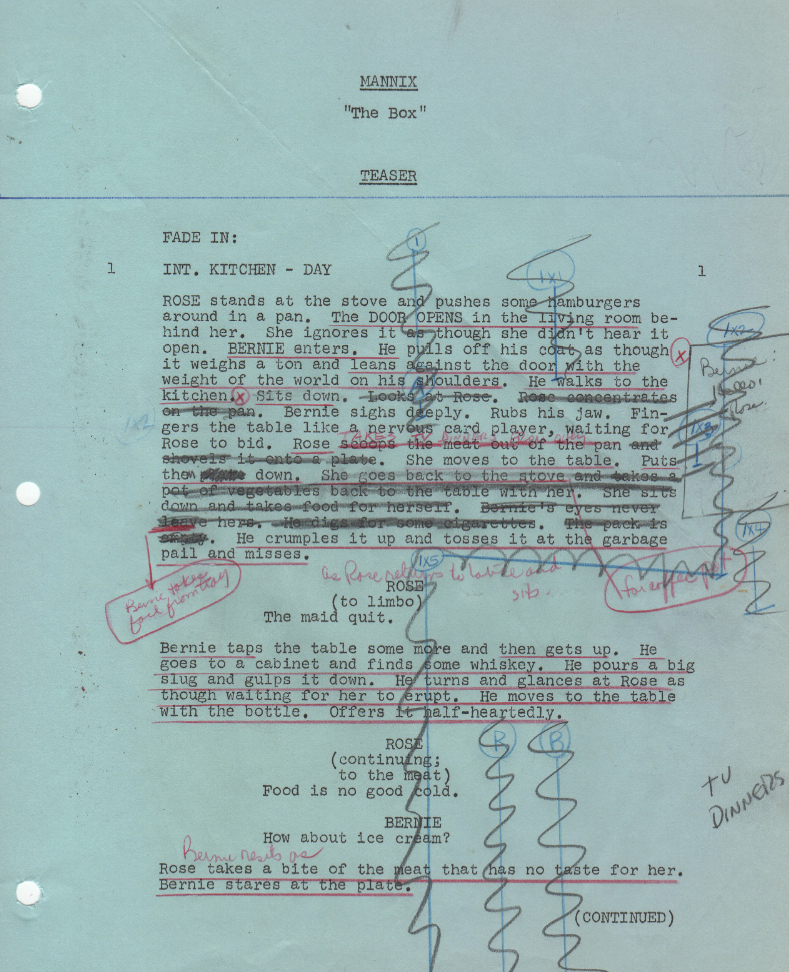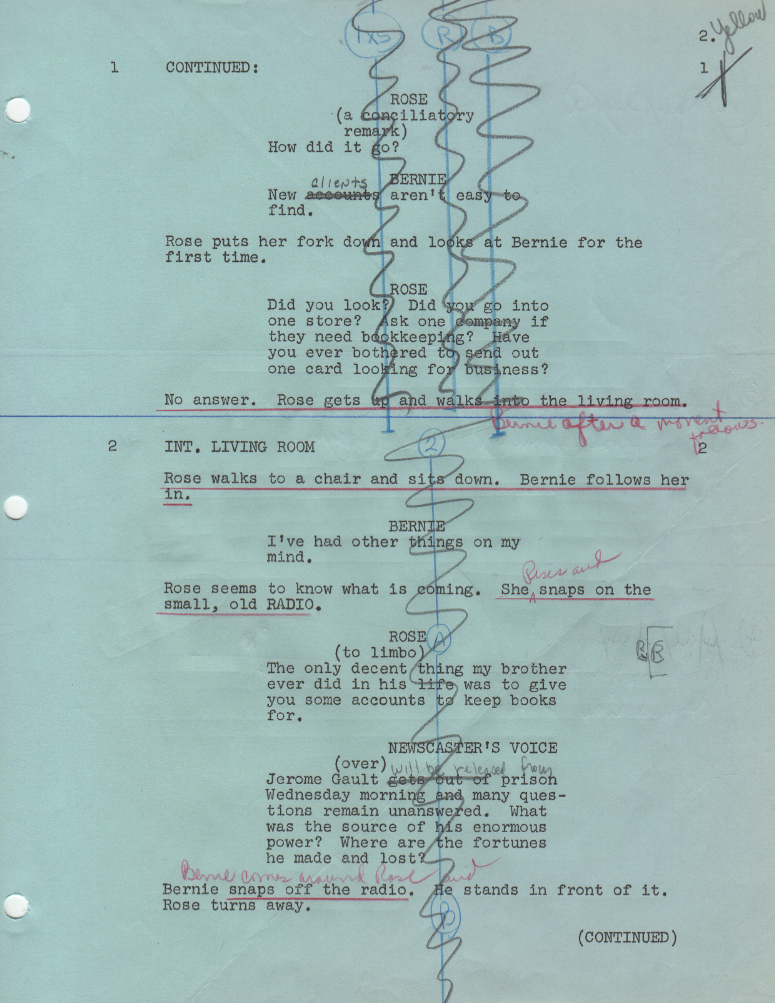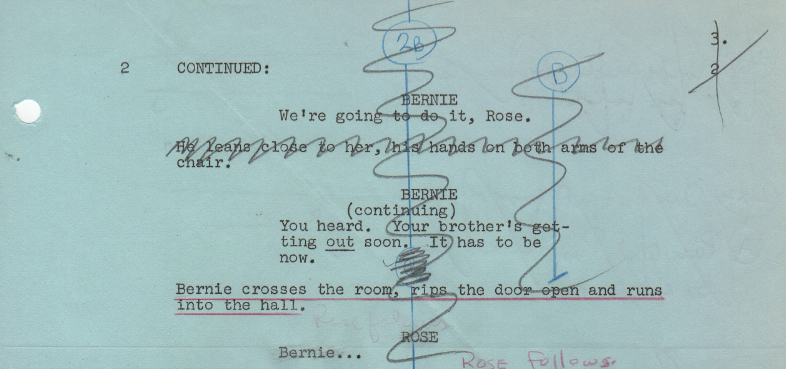FILMED December 1967
Following their success in the 1966-67 season when they sold two successful series to the networks (STAR TREK to NBC and MISSION: IMPOSSIBLE to CBS) Lucille Ball’s Desilu Studios continued on their roll the following season by selling MANNIX to CBS. Developed and produced by Bruce Geller, who had been at the helm of the previous year’s MISSION: IMPOSSIBLE, the new series was a precursor, a forerunner of the series SEARCH, which I discussed in my last post. But by December, when I directed this episode, MANNIX was no longer a Desilu production. Gulf Western, the owner of the neighboring Paramount Studio, had purchased Miss Ball’s little empire, and MANNIX, like STAR TREK and MISSION: IMPOSSIBLE was now a Paramount presentation.
In post-production editing, scenes will be cut for time, but many times cuts will be made to improve. In ANOTHER FINAL EXIT the opening two-page two-minute scene was eliminated. I don’t remember if the cut was made for time or to improve, but my feeling now is it was definitely an improvement



The name of the show on the cover of my script was THE BOX. I think it was Larry Storch’s playing of that last scene that gave the film its new name.
Joe Mannix was a private investigator working for Intertect, a large Los Angeles detective agency that used computers to help solve crimes. I’m sure that was the selling pitch when it was presented to the network, but unlike in SEARCH (which came five years later) the computer angle received scant attention – and that attention compared to what came in the later series was definitely primitive. I think MANNIX owed a greater debt to Mickey Spillane’s Mike Hammer, the lead character in I, THE JURY a detective novel published in 1947, and the first of a long string of very violent and successful Mike Hammer adventures. Computers be damned! Mannix like Hammer was a no-holds-barred private investigator, and his adventures were strictly the four b’s—bullets, beatings and beautiful broads.
I had worked with Joe Campanella the year before when he guest-starred in ANATOMY OF A PRISON BREAK on THE FBI. Because of that great face and demeanor Joe could act roles on either side of the law. ANOTHER FINAL EXIT was the first and only time I worked with Mike Connors, but I seem to remember his being involved in the Hollywood theatre scene a decade before. His name then was Touch Connors. It was as Touch Connors that he made his film debut in 1952 in the Joan Crawford starrer SUDDEN FEAR. Touch was a nickname he picked up in high school, bestowed on him by his basketball teammates. Connors was the name given him by agent Henry Willson, replacing his Armenian name, Ohanian.
There was an advantage that came with the sale of MANNIX to Gulf Western: we were able to use the New York Street set on the adjoining Paramount Marathon lot. It wasn’t extensive, but it served our purposes in this production and eliminated the need for us to go off the lot for several locations to be filmed at night. I don’t remember if Ralph’s Café behind Mannix’s car was already there or whether the art director was giving me a Hitchcock moment.
That was beating #1. Now for broad #1!
During 1967 I directed five STAR TREKs at Desilu Studio, three of them after the sale of Desilu to Gulf Western. MANNIX, which had been created as a Desilu production was now, like STAR TREK and MISSION: IMPOSSIBLE, also under Paramount Studio control. The interesting thing is that I don’t remember that directing ANOTHER FINAL EXIT had the pressures I had felt while directing those three STAR TREKs with their restrictive five-and-a-half day schedules. The MANNIX production was scheduled for eight days, but Paramount wasn’t being as generous as that number indicates.

Since we started filming on Tuesday, December 26, the day after Christmas, the following Monday, New Year’s Day, was a paid holiday for the crew. But we still had seven days scheduled for filming, which was a day more than STAR TREK’s schedule, and the shoot was actually very pleasant.
I had worked with Larry Storch three years earlier when I directed him in THE JACK IS HIGH on SUSPENSE THEATRE. Larry started his professional career when he left high school without graduating because of hard times in the Great Depression. He worked as a stand-up comic and opening act, moved on to musicals and Broadway and eventually Hollywood films and television. He was a magnificent impressionist. Visit my website for THE JACK IS HIGH and see the great scene he did, impersonating W.C. Fields, Cary Grant, Edward G. Robinson and James Cagney while I had him circling and climbing up on top of a gasoline tanker. The thing that always fascinates me is that stand-up comedians turn out to be such sensationally good dramatic actors. Ed Wynn (He won an Emmy)! George Burns (He won an Oscar)! Jack Benny (He won multiple Emmy’s)! Red Buttons (He won an Oscar)! Bill Cosby (He was the first African American to win an Emmy)! Billy Crystal (He won a Tony)! Robin Williams (He won an Oscar)! Lily Tomlin (She won a Tony)! And finally those two great comics who set the standard for excellence so high – Charlie Chaplin and Buster Keaton! I think Larry was in their company.
Many years ago legendary Samuel Goldwyn said, “A rock’s a rock, a tree’s a tree. Shoot it in Griffith Park.” Feature films may have found it more exciting to leave town in search of more exciting locations, but we for budgetary reasons found it more expedient to listen to old Sam and go to the nearby park.
Bernie had remembered that a relative of Harry (their next door neighbor) had a place in San Remo, a place they could hide from Gault. We found it easier to go to nearby Elysian Park in Central Los Angeles. It is the second largest park and also the city’s oldest park. The fact that it is still a park is remarkable. At one point it took some stalwart committee work to prevent the city from building a large Municipal Convention Center on the property.
The director of photography was Gert Andersen. We had worked together earlier that year on the Emmy award-winning THE TRAIN on the impossibly difficult MISSION: IMPOSSIBLE. He was great – he produced fine film noir photography, he was FAST, and he was accommodating and pleasant to work with.
At the end of the first season, Mannix left Intertect and opened his own detective office. With this new format the show continued for another seven seasons. The following season I got entangled in THE THOLIAN WEB on STAR TREK (you can read about that imbroglio on my post for that production) and in the ensuing two decades I never again worked on the Paramount lot.



On a ‘Star Trek’ fan bulletin board (trekbbs.com), someone posted financial details of a report from the ST producers to NBC. NBC was concerned about the cost of ST and wanted an episode cost comparison to similar one-hour series. The report ST sent to NBC (dated 8/28/1967) included this data:
Mannix: $213,378
Mannix: $224,602
Mission: Impossible: $218,004
Star Trek: $189,696
Star Trek: $195,674
Voyage: $166,485
Man From U.N.C.L.E.: $150,158
Wild, Wild West: $181,108
Bonanza: $167,870
Gunsmoke: $192,326
Batman: $184,232
I have no details beyond this, although the poster mentioned Bob Justman’s comments about “creative accounting” regarding ‘Voyage TTBOTS’. I assume the extra work day for ‘Mannix’ vs. ‘Star Trek’ explains a lot.
I can see one reason why Paramount didn’t mind dropping the Intertect angle from ‘Mannix’ after Season One. All those actors, all those extras, all that floor space, all that furniture, all those machines…Gail Fisher in a tiny office will cost you less!
According to Marc Cushman’s magnificent new book, THESE ARE THE VOYAGES (TOS) Second Season, the STAR TREK numbers are high, especially after Gulf Western acquired Desilu Studio and Paramount Studio was in charge.